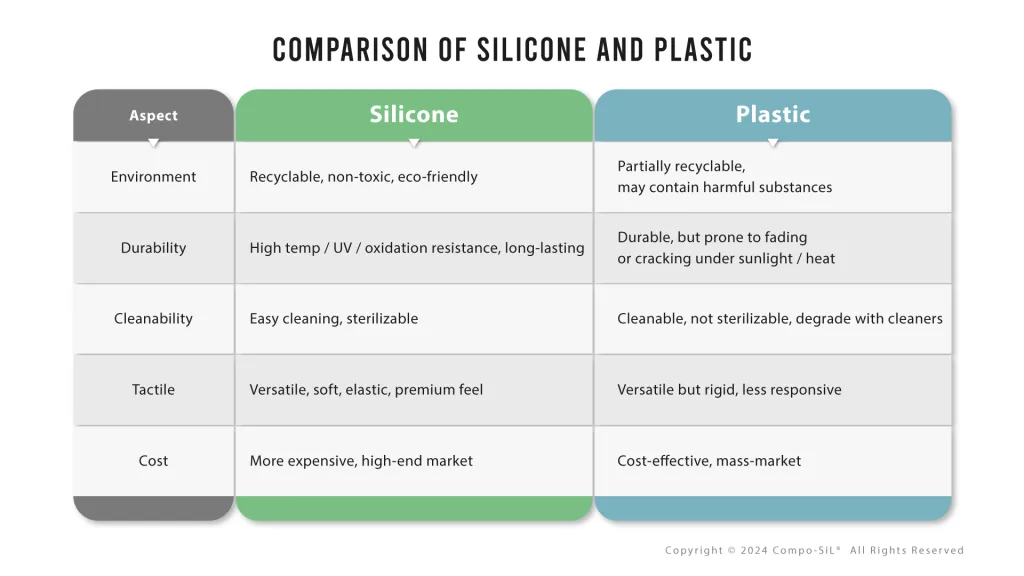Trend Talk: What Keeps Plastic as the Dominant Material in Automotive Interior?
As the automotive industry looks for more sustainable options, plastic remains the material of choice for many surface films in interiors. But with growing environmental awareness, could this trend be changing? In this article, we’ll compare silicone decorative films with plastic decorative films and explore why silicone is emerging as a strong contender for the future of automotive interiors.
As we dive deeper into this comparison, we will examine the key factors—environmental impact, durability, tactile experience, and cost—that differentiate silicone and plastic in the automotive interior market.
🔍 1. Environmental Impact and Sustainability
• Silicone: Silicone is a recyclable material that is non-toxic and releases no harmful substances, making it an environmentally friendly option. With sustainability becoming a key decision-making factor for many consumers, silicone provides an alternative that aligns with sustainable development needs.
• Plastic: While plastics can be recycled, many plastic films are still not fully recyclable and pose a significant environmental burden. Materials like PVC may also contain harmful chemicals, making them less environmentally friendly.
🔍 2. Durability and Longevity
• Silicone: Silicone is highly resistant to high temperatures, UV radiation, and ozone, maintaining stability under extreme conditions. For automotive interiors, this translates to long-lasting beauty and functionality.
• Plastic: While plastic is also durable, prolonged exposure to sunlight and heat can cause it to fade, crack, or become brittle, making it less reliable in harsh environments.
🔍 3. Cleanability and Sterilizability
• Silicone: Silicone is easy to clean and can resist bacteria buildup by adding anti-bacteria agents. Additionally, silicone can be safely sterilized with detergent, ensuring that vehicles maintain a fresh and hygienic interior over time.
• Plastic: Plastic surfaces may also be cleaned but are not suitable for sterilization. Frequent exposure to cleaning agents or disinfectants can cause plastic materials to degrade, potentially releasing harmful substances.
🔍 4. Touch and Appearance
• Silicone: Silicone provides a premium tactile experience, offering a soft, elastic texture that delivers an exceptional and responsive feel. Its inherent flexibility allows for a pleasant, dynamic touch, offering superior feedback when pressed. Additionally, its surface can be easily tailored to various finishes, such as glossy or matte, giving automotive interiors the versatility to meet different design needs.
• Plastic: While plastic can be molded into various shapes, its texture tends to be harder and less responsive compared to silicone. Although it can offer multiple design possibilities, the tactile experience is typically more rigid, lacking the luxurious, responsive feel that silicone provides, especially in high-end applications.
🔍 5. Cost and Market Acceptance
• Silicone: Silicone materials are relatively more expensive, but their superior performance and environmental benefits make them an ideal choice for the high-end automotive market, particularly in areas like dashboards and interior trims.
• Plastic: Plastic is more cost-effective and continues to dominate the market due to its lower production cost, making it the material of choice in mass production and price-sensitive markets.

To wrap up our discussion on the future of automotive interior films, let’s recap the key points. Plastic remains dominant due to its low cost, versatility, and ease of mass production. However, as the automotive industry leans more toward sustainability, the drawbacks of plastic—such as its environmental impact and proneness to degradation—are becoming clearer. On the other hand, silicone’s durability, tactile quality, and eco-friendly properties make it a strong contender for replacing plastic in high-end automotive applications. Its superior resistance to heat, hydrolysis, UV radiation and ozone positions it as an ideal material for the future of automotive interiors.
At the forefront of silicone decorative films, we believe in the power of collaboration to drive sustainable change. If you’re searching for innovative materials to meet your sustainability goals, let’s work together for a more eco-conscious future!
Let’s connect!
LinkedIn
Facebook
Twitter

